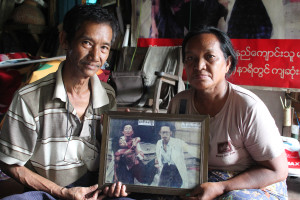A series of reflections on my most recent trip to Burma.
By Jan-Philipp Sendker
Yangon, in the fall of 2013
Today a Burmese friend took me to the countryside—to be more precise, a suburb of Yangon. It was about an hour drive through heavy traffic, passing several large construction sites. After a while things slowed down, and I noticed familiar sights: kids playing soccer on the streets, people strolling around, tea houses on the sidewalks packed with customers. The streets became narrower, wooden buildings and huts replaced the stone houses, water buffaloes crossed the roads. We took a few turns before ending up in a narrow, dead-end lane. We parked the car and within seconds were surrounded by kids smiling at us, laughing, curious what these strange visitors were up to.
My friend and I walked to a small house, and he introduced me to an older couple he wanted me to meet. The husband was a thin, almost frail-looking man in his sixties, but with a very firm, determined voice. His wife invited us inside.
The hut was about 200-square feet. There were altogether twenty people living here, the wife told me with a shy smile.
 The walls were decorated with flowers, Buddhist monks, and photos of the opposition leader Aung San Suu Kyi and her father, the founder of the nation. In the middle hung a very large, almost poster-sized picture of a beautiful but serious-looking teenage girl, one of the couple’s daughters.
The walls were decorated with flowers, Buddhist monks, and photos of the opposition leader Aung San Suu Kyi and her father, the founder of the nation. In the middle hung a very large, almost poster-sized picture of a beautiful but serious-looking teenage girl, one of the couple’s daughters.
We sat down. The woman offered us some tea, while her husband brought out another picture of their daughter. It showed a young girl covered in blood, being carried away by two doctors.
She was 18 years old when she died, her father explained. Shot and killed by soldiers. One among several thousand unarmed students who were mowed down by government troops in the summer of 1988, because they were demanding an end to military rule. Her parents have been fighting for justice ever since. They have been detained. They have been threatened by the secret police.
“We used to want to see people punished,” the man said. “But not anymore.”
He noticed my surprised expression and smiled briefly.
 “You don’t want the people who are responsible for killing your daughter brought to justice?“ I asked.
“You don’t want the people who are responsible for killing your daughter brought to justice?“ I asked.
They both shook their heads, slowly but firmly. “We don’t fight for a trial,” he replied. “We fight for a memorial for all the people who gave their lives for the freedom of the country. We want their sacrifice to be remembered and not forgotten. Remembered at a public space in Yangon, where they died.”
Revenge seemed to be the last thing on their mind.
It is one of the fascinating contradictions in today’s Burma that people are allowed to commemorate uprisings and their victims. They are allowed to mourn the killed, but not allowed to ask: who were the killers? Where are they now? When will they be punished?
“If we ask those questions, it would be the end of the reform process,” my friend whispered. “Because the killers are still in power.”
He had a point. But to me it seemed that this couple had learned something more: for them, justice means more than just punishing the guilty.
After more than an hour, I left the house deeply impressed by this wise and humble couple.